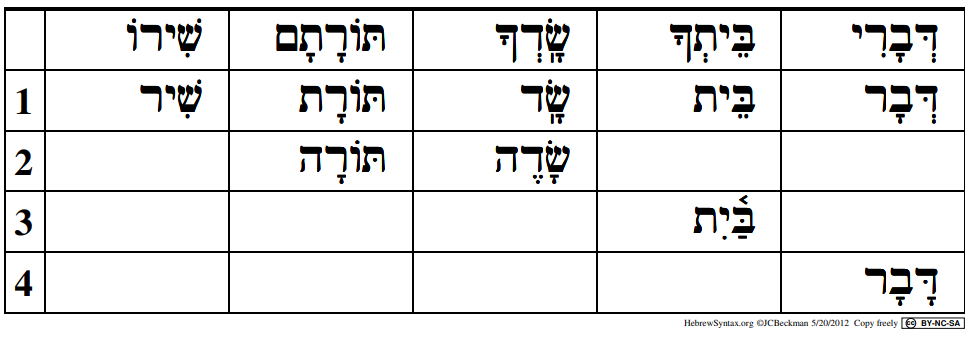9.9 Identifying the Lexical Form with Type 1
Part of learning to read Biblical Hebrew is assembling a set of skills that make it easier to navigate when you encounter an unfamiliar word in the Text.
A noun is more likely to be unfamiliar to you than a preposition, so we’ll focus on nouns. Below is a procedure you may follow that should help with this. The steps for a Type 1 suffix are on this page, and the steps for Type 2 are in the next section.
- Remove the pronominal suffix
- With שִׁיר, we are done at step 1
- Remembering that type one suffixes can only go with SINGULAR nouns, the next step is to fix the singular ending as needed
- If the remaining word has a word-final ת, it is likely feminine. Replace ת ַ or ת ָ with ה ָ (usually)
- See תּוֺרָתָם as an example
- Note בֵּית does not have a feminine ending; we will recognize this word from our vocabulary memory
- If the remaining word does not end with a ת, it is likely masculine. Most often, masculine words are endingless, but sometimes you may need to add the masculine singular ending ה ֶ
- See שָֹדֶה, which is another word that should be memorized
- If the remaining word has a word-final ת, it is likely feminine. Replace ת ַ or ת ָ with ה ָ (usually)
- If there is a word-internal
tsere+yod(i.e. in the middle of the word), replace with the diphthong יִ ַ֫- See word בֵּיתְךָ
- Change other vowels as needed according to the vowel preference table we studied several lessons ago
- See word דָּבָר
Here is Dr. Beckman’s example of the four steps using five example words with Type 1 suffixes. Note that words do not always need all four steps.
